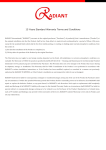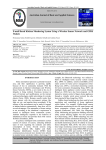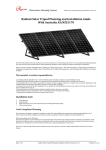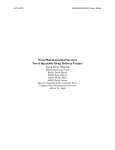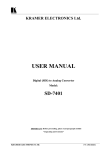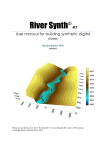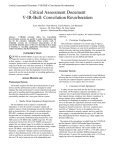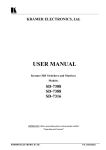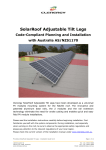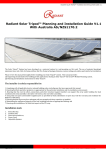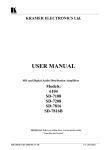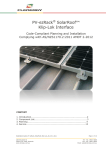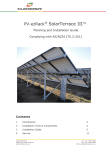Download Function Specification for AWC
Transcript
Proposal for Automatic Window Controller Dr. Andrew Rawicz School of Engineering Science Simon Fraser University Burnaby, British Columbia V5A 1S6 Re: ENSC 305/440 Functional Specification for the Automatic Windows Controller Dear Dr. Rawicz: The following report contains the function specification for our product, the automatic window controller. We are aiming to invent an auto window system that will increase the users comfort and leisure while living in commercial buildings and home. The AWC will solve the problem of people who forget to close or open their window before they leave their home and will make their lives more convenient when they are using the space. In this function specification report, we outlined our test plan, system overview, and requirements and standards for each part of our project. We clearly distinguished between the requirements that will be implemented in our proof of concept model and final product. Smart Window Inc. is consisted of five engineering students: James (ChiaHung) Lee, Steven (Ho Chong) Zeng, Dong Hao Zhuo, Jie Wen Mai, and Jing Xiang Hou. If you have any further questions or suggestions, please feel free to contact us by e-mail at [email protected]. Alternatively, you may also contact us by phone (778) 318-9662. Sincerely, Dong Hao Vincent Zhuo CEO Smart Windows Function Specification for AWC Smart Windows Functional Specifications Project Team: Dong Hao Vincent Zhuo Steven Ho Chong Zeng James (Chia hung) Lee Jie Wen Mai Jing Xiang Hou Contact Person:Dong Hao Vincent Zhuo [email protected] Submitted to: Dr. Andrew Rawicz Steve Whitmore Date: February 16, 2015 1 Function Specification for AWC Executive Summary According to the United States Department of labour, the average employed American spends about 8.7 hours working, 7.7 sleeping, and 2.5 hours doing leisure actives [1]. That is about one third of their day working away from home and another one third spent sleeping. The active time spent at home is less than 8 hours a day, thus a comfortable home environment cannot be maintained manually. Some people close their windows and curtains when they are sleeping; this can lead to interrupted sleep due to rise in room temperature and CO2levels. Those that leave their windows open while sleeping experiences a drop in temperature. It may also start raining in the middle of the night and cause damage to furniture near the window. People also tend to leave their windows closed when they are away from home, thus their rooms become unventilated when they return. The Automatic Window Controller (AWC) aims to provide the user a comfortable indoor living condition by automatically controlling the position of the window and curtains. AWC is designed to be used automatically and manually. Upon completion of the automatic phase, the AWC will provide the following features: Screen display for temperature and humility Automatic adjustment of the windows Automatic adjustment of the curtain Motion detection for safety The features of the AWC are chosen to be safe, user-friendly and provide the most assistive functions to help its user advance though his/her day without needing to worry about indoor living conditions. After the manual phase is complete, the window and curtain will be able to be open and closed using man power. There will be a switch to turn the power on and off. When the power of the circuit is turned off, the window will be no different than a regular window; it will be adjustable by hand. The targeted completion date for this phase of the project is on April 2015. 2 Function Specification for AWC Table of Contents Executive Summary........................................................................................................................2 List of Figures................................................................................................................................. 4 Glossary .........................................................................................................................................4 1 Introduction................................................................................................................................ 5 1.1 Scope...........................................................................................................................5 1.2 Intended Audience .....................................................................................................5 1.3 Classification................................................................................................................5 2 System Requirements..................................................................................................................6 2.1 System Overview.........................................................................................................6 2.2 General Requirements.................................................................................................9 2.3 Physical Requirements.................................................................................................9 2.4 Electrical Requirements...............................................................................................9 2.5 Mechanical Requirements...........................................................................................10 2.6 Environmental Requirements......................................................................................10 2.7 Standards.....................................................................................................................10 2.8 Reliability and Durability .............................................................................................11 2.9 Safety Requirements ...................................................................................................11 2.10 Performance Requirements.......................................................................................12 2.11 Usability Requirements..............................................................................................12 2.12 Luxury Functions........................................................................................................12 3 Gilding Window........................................................................................................................... 13 3.1 General Requirements.................................................................................................13 3.2 Physical Requirements.................................................................................................14 4 Awningng Window.......................................................................................................................14 4.1 General Requirements.................................................................................................14 4.2 Physical Requirements.................................................................................................15 5 Roller Blind...................................................................................................................................15 5.1 General Requirements.................................................................................................16 5.2 Physical Requirements.................................................................................................16 6 User Interface Unit.......................................................................................................................16 6.1 General Requirements.................................................................................................16 6.2 Usability Requirements................................................................................................17 6.3 Physical Requirements.................................................................................................17 7 User Documentation ...................................................................................................................17 8 System Test Plan..........................................................................................................................18 9 Conclusion ...................................................................................................................................18 10 References.................................................................................................................................19 3 Function Specification for AWC List of Figures and Tables Figure 1: High-Level Functional Block Diagram Figure 2: Window adjustment guidelines Table 1: Room Temperatures Corresponding to Activities Glossary AAMA American Architectural Manufacturers Association BIFMA Business and Institutional Furniture Manufacturers Association NAFS North American Fenestration Standard CGSB Canadian General Standard Board CSA Canadian Standards Association WDMA Windows and Doors Manufacturers Association WCAA Window Coverings Association of America MTBF Mean time between failures Sill Height Distance between floor and lowest part of window frame [2]. Gliding window Window with a moving panel that slides to the left or the right to open [3]. Awning Window that is hinged on the top and opens outward with a turn of a crank handle [3]. A person with the following characteristics. AWC User Assistive Height above 111cm (maximum sill height)[2]. Able to apply enough force to open and close a window. To provide a mean that reduces the amount of work required for a person. 4 Function Specification for AWC Roller Blind A curtain installed in a metal pole and operated with a side chain or a spring mechanism [4]. 1 Introduction The Automatic Window Controller (AWC) is a device used for ventilation in commercial buildings and residential homes. AWCcontrols the windows and curtains based on the indoor and outdoor conditions of a building. By sensing temperature, humidity, rain, and sunlight, the AWC can adjust the position of the window and curtain in a room to improve the living environment. 1.1 Scope In this function specification the functional requirements and standards that must be met by a functioning AWC is outlined. These sets of requirements and standards are used to design and build a proof-of-concept device and also describe the final product. 1.2 Intended Audience The function specification is meant to be used by all members of Smart Windows Inc and also any professional personnel assisting in the development of the AWC. 1.3 Classification The following format is used to represent the functional requirements throughout the document: [Rn-S]A functional requirement. n denotes the functional requirement number S denotes the stages in development in which the requirement must be met I II III Requirement to be met in the proof-of-concept model. Requirement to be met in both the proof-of-concept model and the final product. Requirement applies to the final product. 5 Function Specification for AWC 2 System Requirements General requirements applicable to the AWC as a complete system are presented in this section. 2.1 system overview The AWC is a system that can be modeled as shown in Figure 1. Figure 1: High-Level Functional Block Diagram Due to time constrains in the first stage of development, the window will sense only a few environmental elements and move automatically in only two directions. These elements include outdoor rain, indoor temperature and humidity, and brightness. The sensor system of our project will sense the outdoor rain droplets and close the window to prevent any rain damage. The window also reacts to indoor temperature. It will adjust the indoor temperature to be within a comfortable living range by adjusting the position of the window. The curtain will adjust its position to maintain desirable indoor lighting conditions. In the later stages of development, the window will also be able to detect gas leakage. Several changes will be applied to the original functions. The rain sensor will be able to be disabled manually to allow cleansing of the window. The curtain will be able to be replaced with more desirable ones by the user. The adjustments of the window and curtain will be able to be operated manually like a regular window and curtain. Users will also be able to intelligently modify their preferred room temperature, humidity, and brightness using an electronic user interface. Our AWC operates with a series of rules. Phases and paths in the program specifically determine the priorities of each situation. Each parts of AWC will cooperate accurately to accomplish multiple or complex tasks. 6 Function Specification for AWC One important aspect of the AWC is that the window and curtain cannot be manually adjusted when it is in automatic mode. This window is designed to be able to detect harmful gases. Once the detection of a gas leakage is confirmed, the window will not be closed unless the system is shut down. The system starts with its settings in default. The default setting is chosen to accommodate for the majority of the population. As suggested by Smart Windows Consultant, the ideal indoor environment that is comfortable to most people is described as follows: Temperature: The room temperature recommendations for summer and winter may vary; a suggested typical range for summer is 23 °C (73 °F) to 25.5 °C (78 °F), and for winter is 20 °C (68 °F) to 23.5 °C (74 °F) [5]. Brightness: Amount of lighting required for a room depends on the size of the room and the purpose of the room. Intricate tasks require more lighting and just moving around the room requires much less. The amount of light required in an area is defined as “LUX” level which is equal to lumens/area (lm/m2). Below is a table that provides a good idea of LUX level for various tasks [6]: Activity Illumination(LUX) Public areas with dark surroundings 20 – 50 Simple orientation for short visits 50 – 100 Working areas where visual tasks are only occasionally performed 100 – 150 Warehouses, Homes, Theatres, Archives 150 Easy Office Work, Classes 250 Normal Office Work, PC Work, Study Library 500 Table 1: Room Temperatures Corresponding to Activities 7 Function Specification for AWC Figure 2: Window adjustment guidelines 8 Function Specification for AWC 2.2 General Requirements [R1-I] The manufacturing cost of the controller is less than $200. [R2-II]The windows should have two modes which can set the functions to manual and automatic. [R3-III]All the sensors and gears are totally safe to the user. 2.3 Physical Requirements [R4-II]The width of window should be less than 1500mm. [R5-II]The height of window should be less than 1200mm. [R6-II]The window controller shall look stylish. [R7-III] The AWC should be installed in the wall for safety reasons. 2.4 Electrical Requirements [R8-II]The power cord shall be less than1 cm in diameter to fit in the box which it is placed into. [R9-III]The power supply shall be at least 20V to provide enough energy for motors. [R10-III]The plug-in power adapter shall meet the requirements of North American Standard voltages (110V/120V) at 60Hz AC. [R11-III]The whole system turns into energy conservation mode if all conditions remain constant for 15 minutes. [R12-III]Essential voltage nodes shall be measurable for debugging and trouble shooting. [R13-III]A backup power supply system can provide power source when there is a power outage. [R14-III]The backup batteries shall be easy to install and replace. 9 Function Specification for AWC [R15-III]AWC shall have at least 100,000 hours of life performance. 2.5 Mechanical Requirements [R16-II]All parts can be moved and adjusted by manually using mechanisms tools. [R17-II]The windows and curtains shall be able to move smoothly. [R18-II]The windows and curtains shall be able to adjust manually by turning the controllers to manual mode. [R19-III]The mechanical components of AWC shall be invisible and not physically obtrusive. 2.6 Environmental Requirements [R20-II]AWC shall be operational under temperatures between (-20-30°C). [R21-II]The controller shall be functional within an elevation range from sea level to 1500m above sea level. [R22-II]The controller shall be functional under the humidity range between 0-100%. [R23-III]AWC shall be water proofed. [R24-III] AWC shall minimized the noise from operation be less than 50 dB. 2.7 Standards [R25-III]AWC shall meet the CGSB-43.212-2008 requirement. [R26-III]The windows shall meet all AAMA 101/I.S.2/A440-11 standards. [R27-III]The mechanical parts shall meet all BIFMA standards. 10 Function Specification for AWC 2.8 Reliability and Durability [R28-II]The window shall be serviceable by trained technicians. [R29-II]The curtain shall be resistive to water and heat. [R30-III]The window shall be able to withstand daily physical treatment. [R31-III]The window shall be able to withstand heavy weather. [R32-III]The electrical components shall be able to remain powered 24/7. [R33-III]The display screen be resistance to damage from normal operating conditions. [R34-III]The MTBF of the window and curtain shall be no less than 5 years. [R35-III]The curtain shall have a duty cycle of at least 1,000,000 cycles. 2.9 Safety Requirements [R36-II]The electrical component of the window shall not be a hazard for electrical fire. [R37-II]The window shall not cause bodily harm to the user while operating automatically. [R38-II]The window shall be able to detect obstructions. [R39-II]The display screen shall not shock its user while being touched. [R40-II]The electronic component and power connections shall be enclosed. [R41-II]The curtain shall not fall under normal operating conditions. [R42-III]The window and curtain shall be able to detect electrical and mechanical failure and shut off if needed. [R43-III]The window shall not shatter under normal operating conditions. [R44-III]Shattered glass shall not scatter over a wide area. 11 Function Specification for AWC 2.10 Performance Requirements [R45-II]The window and curtain shall complete one operation cycle within 10 s. [R46-II]The window and curtain shall respond to mode changes within 500 ms. [R47-II]The display screen shall display its current mode, temperature and humidity. [R48-II]The display screen shall update within 100 ms if changes are detected. 2.11 Usability Requirements [R49-II]The manual force required to adjust the window and curtain shall be low enough such that the average person can operate them easily. [R50-II]The heat output of the electrical component shall have a minimum effect on room temperature. [R51-II]The curtain shall be easily replaceable. [R52-III]The window shall perform adjustment assuming that the user has set the desire temperature. [R53-III]The curtain shall perform adjustment assuming that the user has set the desire brightness level. 2.12 Luxury Functions [R54-II]The window shall automatically adjust based on indoor temperature and humidity. [R55-II]The curtain shall automatically adjust based on indoor brightness. [R56-III]The display screen shall show a warning if the temperature is too hot or too cold. [R57-III]The window and curtain shall be adjustable using a touch screen display. [R58-III]The noise output of the motors shall not be high enough to disturb a sleeping person. 12 Function Specification for AWC 3 Gliding window The advantages of using a gliding window are the following: Low maintenance cost due to having fewer parts than a conventional window Lower energy bill due to improve insulation and energy efficiency Longer life span due to fewer moving parts Easy to use due to window being light weight and glides along window frame easily Gliding windows are popular in residential houses, apartments, and offices due to it being low maintenance and having no protruding parts. The one disadvantage of a gliding window is that it is difficult to clean the outside of the window because it cannot be tilted inside. The following requirements for the gliding window reflects the guidelines prescribed by AAMA [7] 3.1 General Requirements [R59-II]The window shall be adjustable manually [R60-II]The window shall be parallel to the ground. [R61-II]The window can be moved left and right. [R62-II]The force applied to the window by the motor is uniform [R63-III]The increments of stepper motors for the window shall be less than 1.5mm. [R64-III]The minimum structural pressure of the window shall be 1800 pa [7]. [R65-III]The minimum water pressure of the window shall be 180 pa [7]. [R66-III]The air leakage resistance of the window shall be no more than 75 pa [7]. [R67-III]The transparency shall be at least 90%. 13 Function Specification for AWC 3.2 Physical Requirements [R68-II]The width of the window shall be less than 1500mm [7]. [R69-II]The height of the window shall be less than 1300mm [7]. [R70-II]The window shall look stylish and modern. [R71-II]The window shall be rectangle shaped. [R72-III]The sill height of the window shall be at least 36 inches above the floor. [R73-III]The window is secured to the wall and cannot be removed easily. 4 Awning Window The advantages of using an awning window are the following: Can have a higher placement than other windows Can be opened during rainstorm and prevent water seeping into the space Looks better in higher placement Awing windows are commonly used in commercial buildings, apartments, and high buildings due to its better ventilation and high placement options. The disadvantage of an awning window is that it protrudes when the window is open. Also, awning windows require frequent cleaning because the opened panel is slanted and becomes dirty faster than other windows. The following requirements for the awning window reflects the guidelines prescribed by AAMA [7] 4.1 General Requirements [R74-II]The window shall be adjustable manually [R75-II]The window shall be parallel to the ground. [R76-II]The window can be moved in and out. [R77-II]The force applied to the window by the motor is uniform. 14 Function Specification for AWC [R78-II]The maximum angle when the window is opened shall not exceed 45 degree [8]. [R79-II]The awning window is installed on top of the gliding window. [R80-III]The transparency shall be at least 90%. [R81-III]The minimum water pressure of the window shall be 390 pa [7]. [R82-III]The air leakage resistance of the window shall be no more than 300 pa [7]. [R83-III]The increments of stepper motors for the window shall be less than 1.5mm. [R84-III]The minimum structural pressure of the window shall be 2880 pa [7]. 4.2 Physical Requirements [R85-II]The window shall look stylish and modern. [R86-II]The window shall be rectangle shaped. [R87-III]The window is secured to the wall and cannot be removed easily [R88-III]The sill height of the window shall be at least 36 inches above the floor. [R89-III]The width of the window shall be less than 1500 mm [7]. [R90-III]The height of the window shall be less than 900 mm [7]. 5 Roller Blind The roller blind’s primary function is to control contaminants, temperature, odors, sound and light. The advantages of a roller blind are the following: Stay clean longer Resistant to most chemical Easy to install, clean and replace 15 Function Specification for AWC The following requirements for the awning window reflects the guidelines prescribed by WCAA [8] 5.1 General Requirements [R91-II]The roller blind shall be adjustable manually [R92-II]The blind can be moved up and down. [R93-II]The curtains are installed on top of the awning window. [R94-II]The brackets shall be levelled on either side. [R95-III]The blind shall be installed with appropriate child safety component. [R96-III]The increments of stepper motors for the roller blind shall be less than 1.5mm. [R97-III]The transparency shall be at most 5%. 5.2 Physical Requirements [R98-II]The blind skin or cloth shall be cut rectangular [R99-II]The weight of blind shall be less than 5 kg [9]. [R100-III]The width of the blind shall be no less than 500 mm [8]. [R101-III]The drop of the blind shall be no less than 1000 mm [8]. 6 User Interface Unit The user interface unit shall consist of a set of buttons or a touch screen display as its input. The output of the user interface shall be displayed on the touch screen. 6.1 General Requirements [R102-I]The primary means of user input shall be through a set of buttons switches 16 Function Specification for AWC [R103-II]The user interface unit shall have a power off switch. [R104-II]The outputs on the user interface unit shall consist of status indicators to indicate power on, automatic mode and manual mode. [R105-III]The outputs on the user interface unit shall consist of data to each mode. [R106-III]The user interface unit shall allow the user to select various modes including but not limited to: automatic mode, manual mode, and setting mode. [R107-III]The user interface unit shall allow the user to setup various data including but not limited to: window position, curtain position, temperature, humidity, and lighting. 6.2 Usability Requirements [R108-II]The user interface unit shall turn on when the power switch is turned on. [R109-II]The manual adjustment interface shall be intuitive and easy-to-use. [R110-III]The user shall be informed through the user interface unit when the initial setup for data is complete. 6.3 Physical Requirements [R111-II]The control panel shall be easily accessible to the user. [R112-II]The control panel shall be placed close to the window. [R113-II]The control panel shall be placed inside the room. [R114-III]The control panel shall be placed so that children under 10 shall not have access 7 User Documentation [R102-III]The user documentation shall provide websites and resources with general information and technical support. [R103-III]The user manual shall be written in simple knowledge and basic electrical terms. 17 Function Specification for AWC [R104-III]User documentation shall be written in English, Simplified and traditional Chinese, French, and Spanish for the North American market. [R105-III]A detailed installation guide and contact information shall be provided. 8 System Test Plan The test plan for this product is separated into many phases and parts. OurChief of Marketing Office will provide a more complete test plan, once the proof of concept model is completed. The testing procedure will meet the CSA and CGSB standards for our final product and prototype. Also, the test methods will become more accurate as improvements to our model are made. Firstly, the dimensions of each individual part need to meet a certain requirement for aesthetic reasons. Therefore, we use software programs Paint and Sketchup to draw blueprints for each components of the AWC. Once the blueprint is finished, we can use it to produce a downscaled version for our model. The gears and its components are first tested to ensure it meets a minimal life span. We can program our software to rotate the gear and chain for 2,000,000 cycles. The weight of the window and curtains are also taking into consideration during this testing phase. The window is consisted of two components, the frame and the glass. These components will be tested separately. The glass will undergo shatter and temperature testes to ensure it is strong enough to withstand extreme weather conditions. The frame will undergo structural strength testes which will apply force to each side of the frame until breakage. Also, air and water leakage testes and weather resistant testes will be performed. Once each component is testes and meets legal requirements, the window will be tested as a whole. The window will undergo tests in weather resistance, air leakage, structural integrity, and durability. To confirm that the power supply has sufficient power to drive the controller and motors for window and curtain,our power supply will supply power to our device for long durations of time. Different stress load will be applied to the power supply in a room with varying temper to ensure that it doesn’t over heat. 9 Conclusion In this functional specification report, the requirements and functionalities of the AWC are outlined. The design will take place in two phases, automatic and manual. All standards and 18 Function Specification for AWC requirements in the proof of concept model above marked with II are currently being used as guidelines for our prototype. The prototype is currently underway and is expected to be completed by April 16, 2015. 10 Reference [1] Bureau of Labor Statistics (2014). Retrieved from: http://www.bls.gov/tus/charts/ [2] WindowDoor (2012). Retrieved from: http://windowanddoor.com/article/codesstandards/international-code-requirements-windows-doors [3] RealSimple (2015). Retrieved from: http://www.realsimple.com/home-organizing/homeimprovement/renovations/types-windows/awning [4]Window Blind (2015). Retrieved from: http://en.wikipedia.org/wiki/Window_blind#Roller_Blinds [5] Room Temperature (2015). Retrieved from: http://en.wikipedia.org/wiki/Room_temperature [6] Bijli Bachao (2013). Retrieved from: https://www.bijlibachao.com/lights/how-much-lightingis-good-lighting-for-a-room.html [7] Bijli Bachao (2013). Retrieved from: http://www.aamanet.org/upload/file/CMB-5-11.pdf [8] Custom Roller Blind Standards. Retrieved from: http://www.wcaa.com.au/site/DefaultSite/filesystem/documents/Custom-Roller-BlindStandards.pdf [9] Turnils (2006). Retrieved from: https://www.google.ca/url?sa=t&rct=j&q=&esrc=s&source=web&cd=1&cad=rja&uact=8&ved= 0CBwQFjAA&url=http%3A%2F%2Fweb.turnils.com%2FImageVault%2FImages%2Fid_2315%2Fsc ope_512%2FImageVaultHandler.aspx&ei=jJndVOvbE8KYNvSegOgD&usg=AFQjCNEzXI7K6dViwZj 2DHFKTLJqK6M2kA 19




















